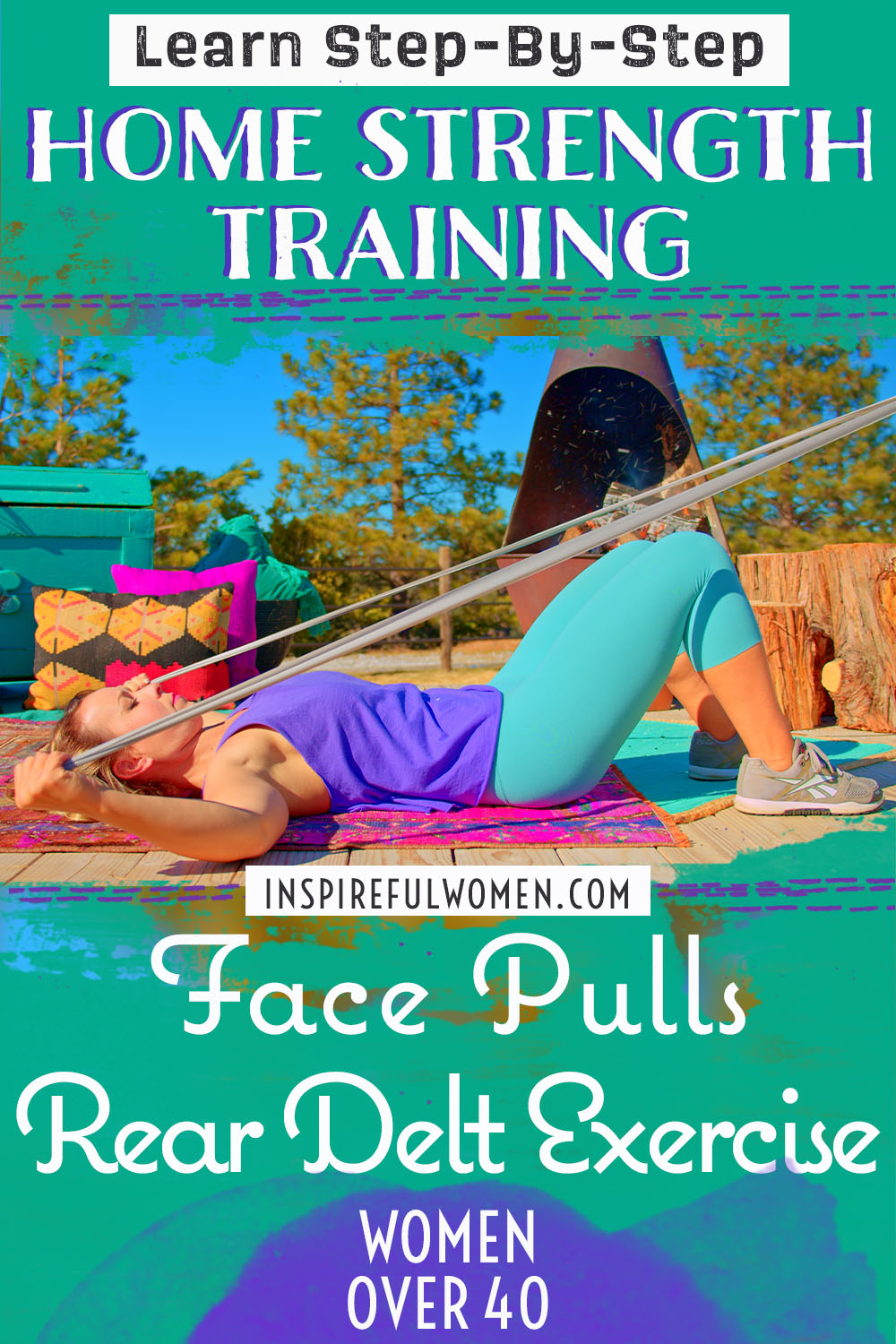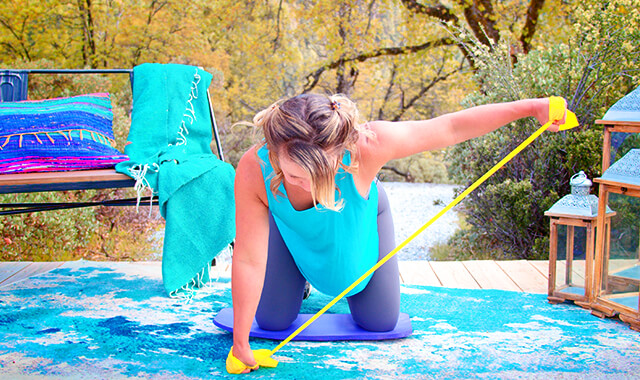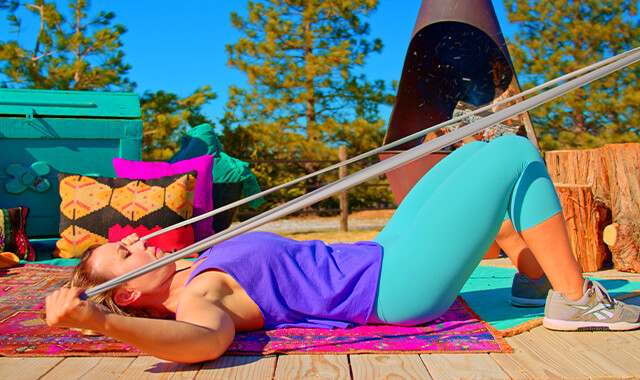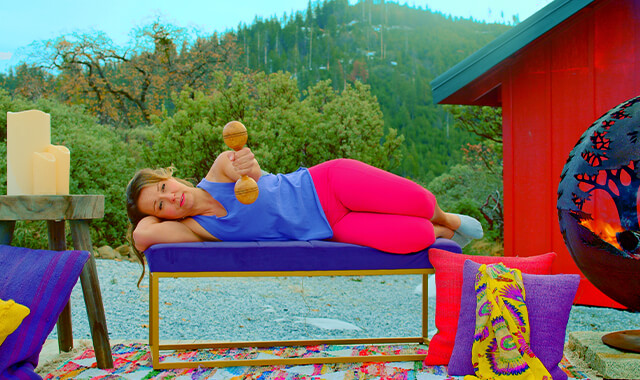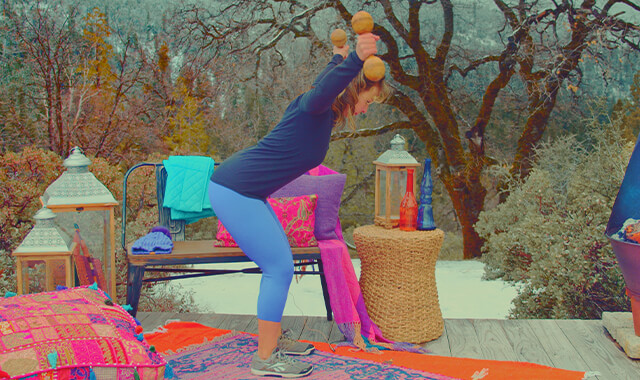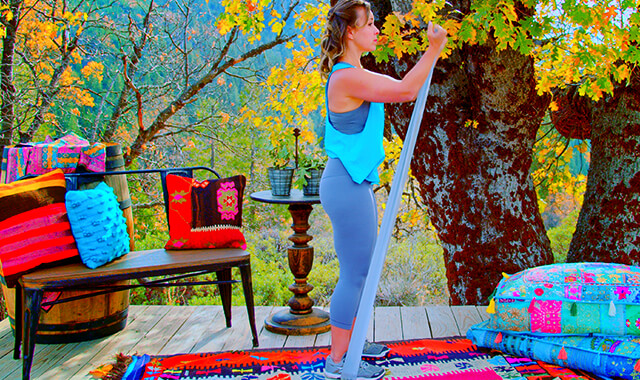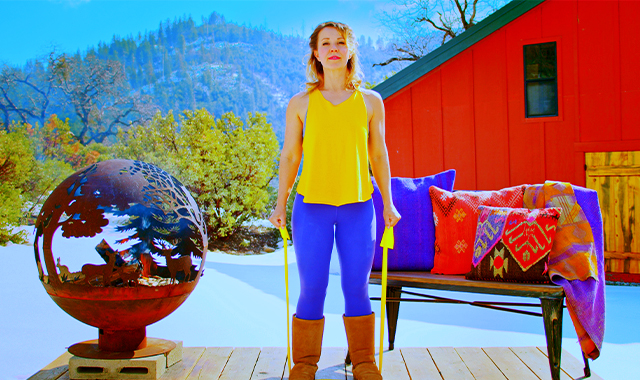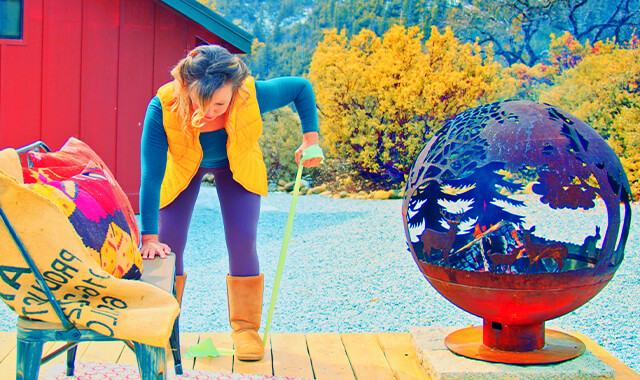Single arm Face Pull with Thoracic Rotation
How to Do Single Arm Band Face Pulls with Torso Rotation - Rear Delt Exercise at Home | In-Depth Guide [VISUAL LEARNERS] Beginner
Proper Form & Common Mistakes | Home Resistance Training
WHAT DO YOU WANT TO SEE?
QUICK DEMO
QUICK DEMO
MUSCLES THIS WORKS
MUSCLES
MAIN MUSCLES WORKED IN single arm face pulls torso rotation
REAR DELTOID, INFRASPINATUS, & TERES MINOR
OTHER MUSCLES WORKED:
- Middle and Lower Trapezius
- Rhomboids
- Latissimus Dorsi
STARTING POINTERS
Starting Pointers
WHAT WE'RE DOING TODAY
ALL WE'RE DOING:
Pulling a band towards our faces. Thus the name face pull. Get it?
The Single Arm Face Pull with Thoracic Rotation is a highly effective band rear delt exercise that targets the upper back, rear shoulders, and rotator cuff muscles. This face pull shoulder exercise at home not only improves your upper body strength but also enhances shoulder stability and mobility.
This variation of the face pull exercise works one arm at a time and will add some movement of the ribs and upper back (thoracic spine). The thoracic spine is a part of the spine that frequently gets stiff (unlike the low back which tends to move too much). Rotating the upper back slightly with arm movements can help to loosen the stiff joints and improve your shoulder motion. The rotational movement will also work the obliques more. This movement is a good way to warm up your upper back and shoulders (without the use of a band).
HOW TO DO THE EXERCISE
LOOKS
HOW Single arm Face Pulls SHAPE OUR BODY
Good posture; balanced capped shoulders.
PROPER FORM
PROPER FORM: Single arm Face Pull w/ torso rotation
EQUIPMENT, SETS & REPS
EQUIPMENT
Main set (3: Light/Med/Heavy)
X-Heavy Band (I recommend getting this too if you plan to use resistance bands frequently).
SUGGESTED STARTING WEIGHT FOR WOMEN:
Light to moderate resistance.
SETS & REPS:
2 sets of 8 reps.
PACE:
Moderate pull back and slow return to the starting position.
BODY POSITION
BODY POSITION FOR single arm face pulls torso rotation
BAND: Anchor the band 4-6 inches above your head.
FEET: Stagger feet with your foot on the side of your working arm back about one step in length. Shoulder width or slightly wider, toes straight ahead.
BODY STANCE: Knees slightly bent. Neutral spine. Sternum lifted. Abdominals gently engaged. Hips and shoulders should be squared to the front.
ARMS: Working Arm: lifted up, upper arm in line (70 -90 degrees of flexion) or just slowly lower than your shoulder. Elbow bent with your hand slightly wider than elbow width apart or hand right in line with elbow (70 -90 degrees of elbow flexion). Your hand should be around nose level.
Non-working Arm: can be on your hip, or in the starting position.
HANDS/GRIP: Neutral grip on the band, palm facing inward and thumb pointed backward. Stand so there is no slack in the band.
HOW TO DO
HOW TO DO single arm face pulls w/ thoracic rotation
CUE: Keep your hip squared to the front but your upper body will rotate back - like pulling an arrow back in the bow. This is not a big movement.
Working arm - pull your shoulder blade back and down, then pull your elbow back keeping it at shoulder height or slightly lower the entire time, then rotate your forearm back.
It is fine for your head to rotate if that feels more natural - it may help to let your eyes follow your hand as it pulls back.
As your right shoulder blade and arm travel back, let your upper back rotate slightly.
Return to the starting position by reversing your movements with slow control.
HOW TO SAFELY GET OUT OF THE EXERCISE
From the starting position, release the band.
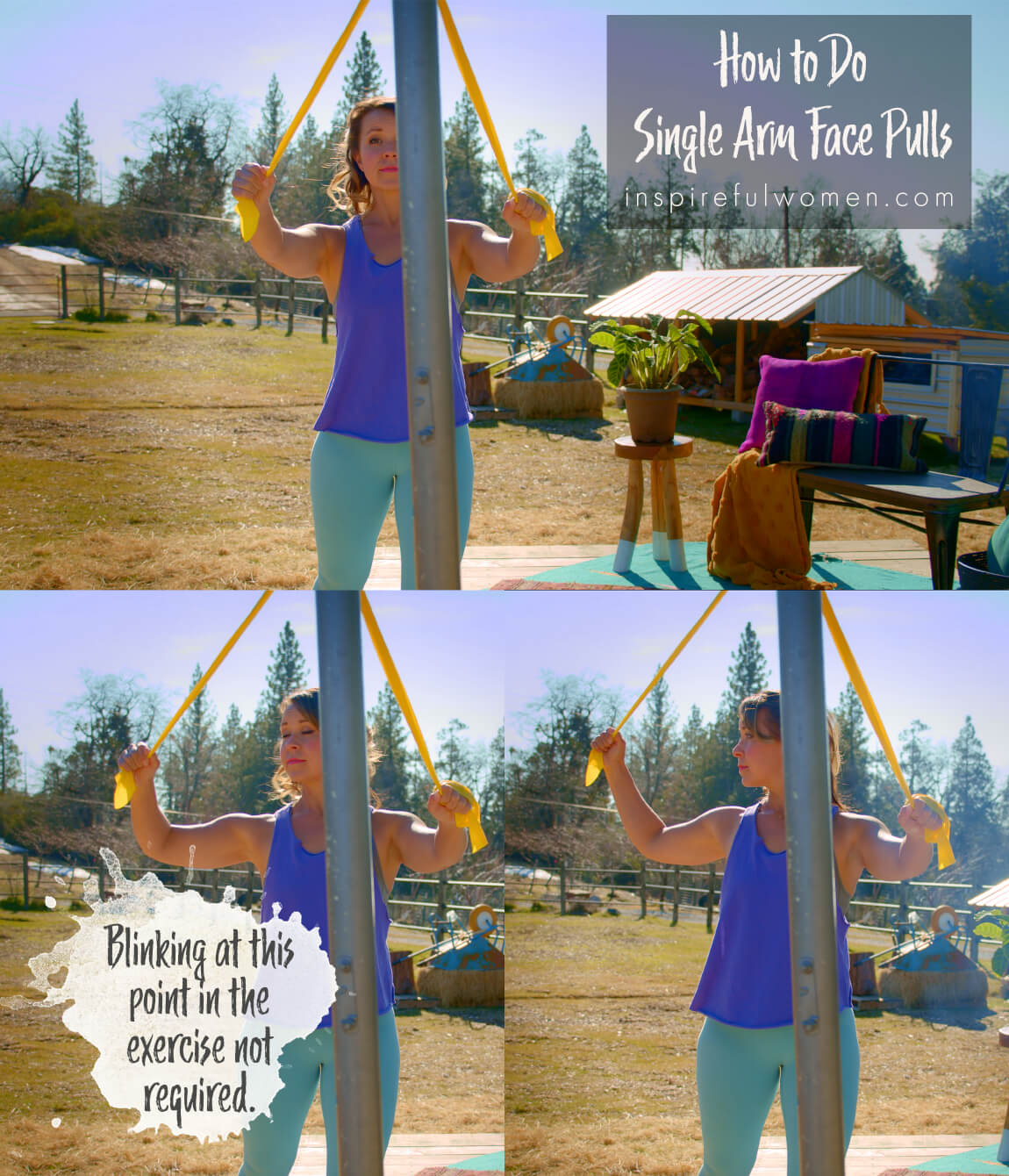
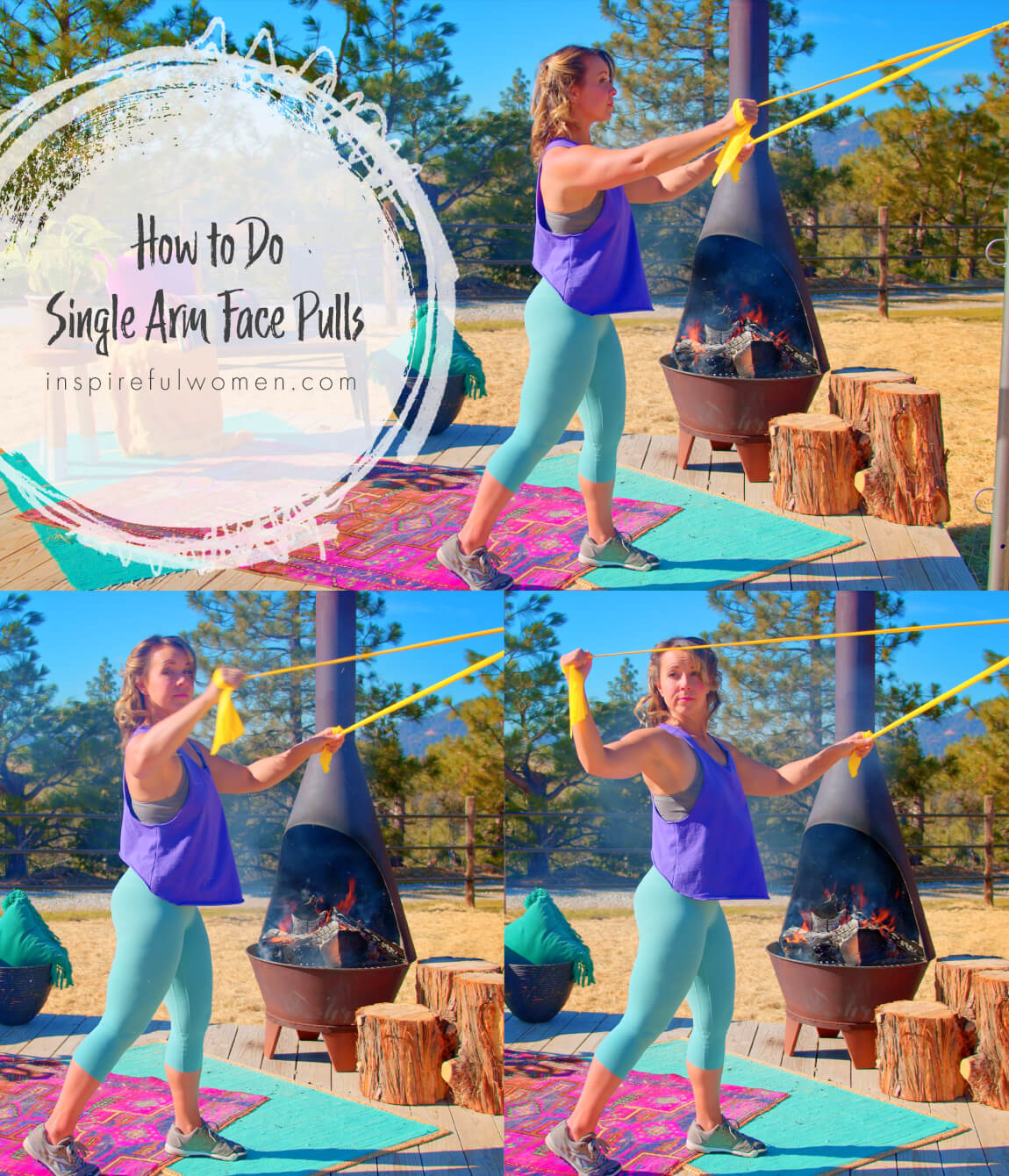
COMMON MISTAKES
COMMON MISTAKES
WHAT TO AVOID WITH THE single arm face pull torso rotation
KEY TIP:
Guess what? Good news! Many avoids are the same for most movements. Once you learn the basics, there's really only a few extra avoids for each individual movement.
1. Avoid Band Hip Rotating Back
AVOID: Rotating the lumbar spine.
WHY NOT?
- The lumbar spine tends to have too much motion (hypermobile) while the thoracic spine tends to be stiff (hypomobile)
- The goal of this variation is to increase the movement of the thoracic spine.
- Rotating the lumbar spine over and over, especially under load (resistance band) can irritate the low back.
WHAT TO DO:
- Keep the hips squared to the front as the shoulder of the working arm moves back.
- Keep equal weight on the left and right foot.
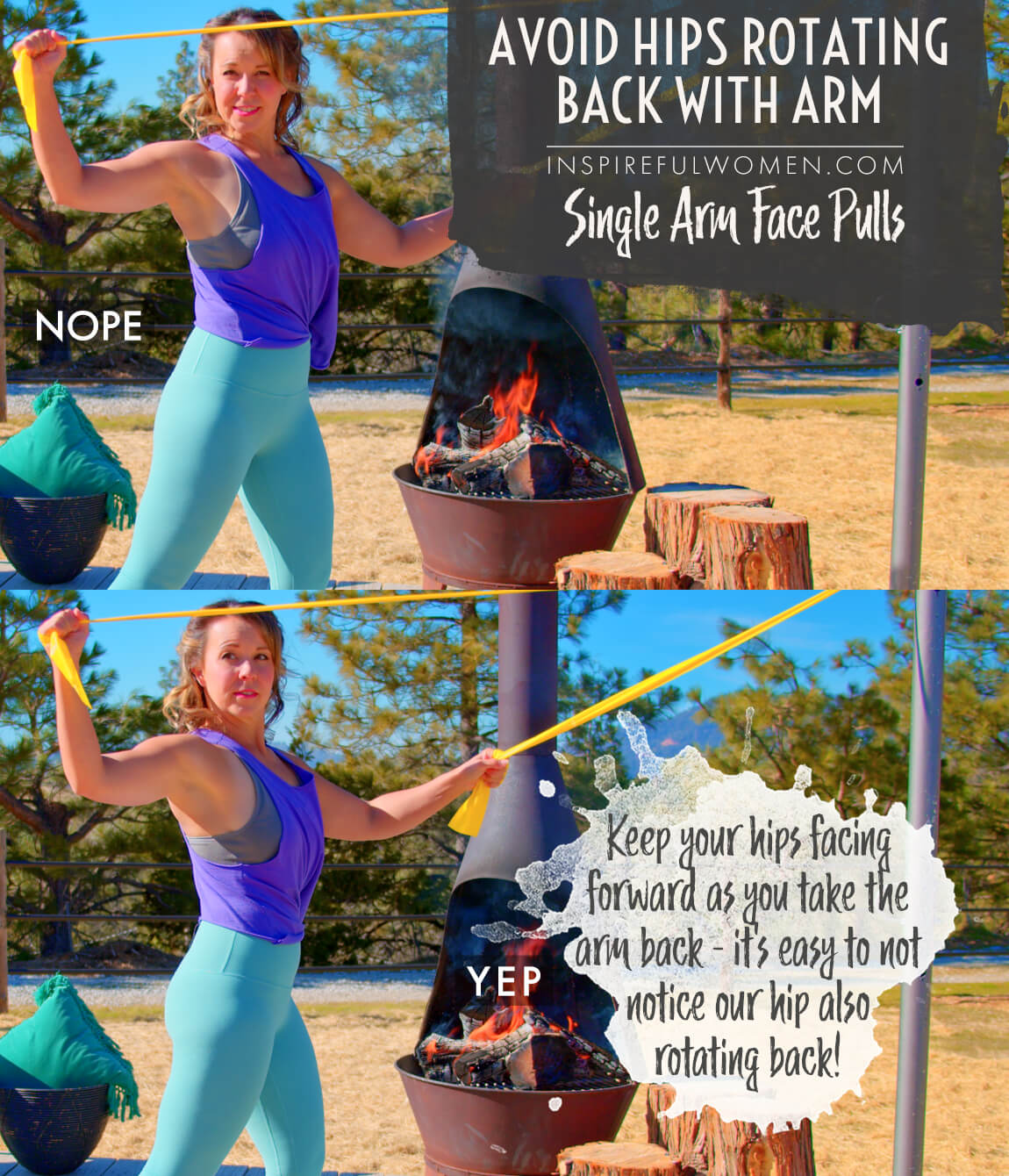
2. Avoid Band Torso Leaned Over Or Back
AVOID: Leaning back.
WHY NOT?
- This will decrease the work being done by the muscles of the arms and upper back
- This is a common way the brain will try to make the exercise easier - using your body weight to pull the band back by leaning backward.
WHAT TO DO:
- Keep the shoulders over the hips, over the feet.
- Bend the knees slightly and activate your core muscles.

3. Avoid Arm Held Too Low
AVOID: Letting the elbows drop as you pull the arms back.
WHY NOT?
- Letting the arms drop will decrease the activation of the scapular retractors and the latissimus dorsi will be more active.
WHAT TO DO:
- Keep the elbows in line with the shoulder joint or a little lower.
- The hands should be around nose level as they get by your ears.
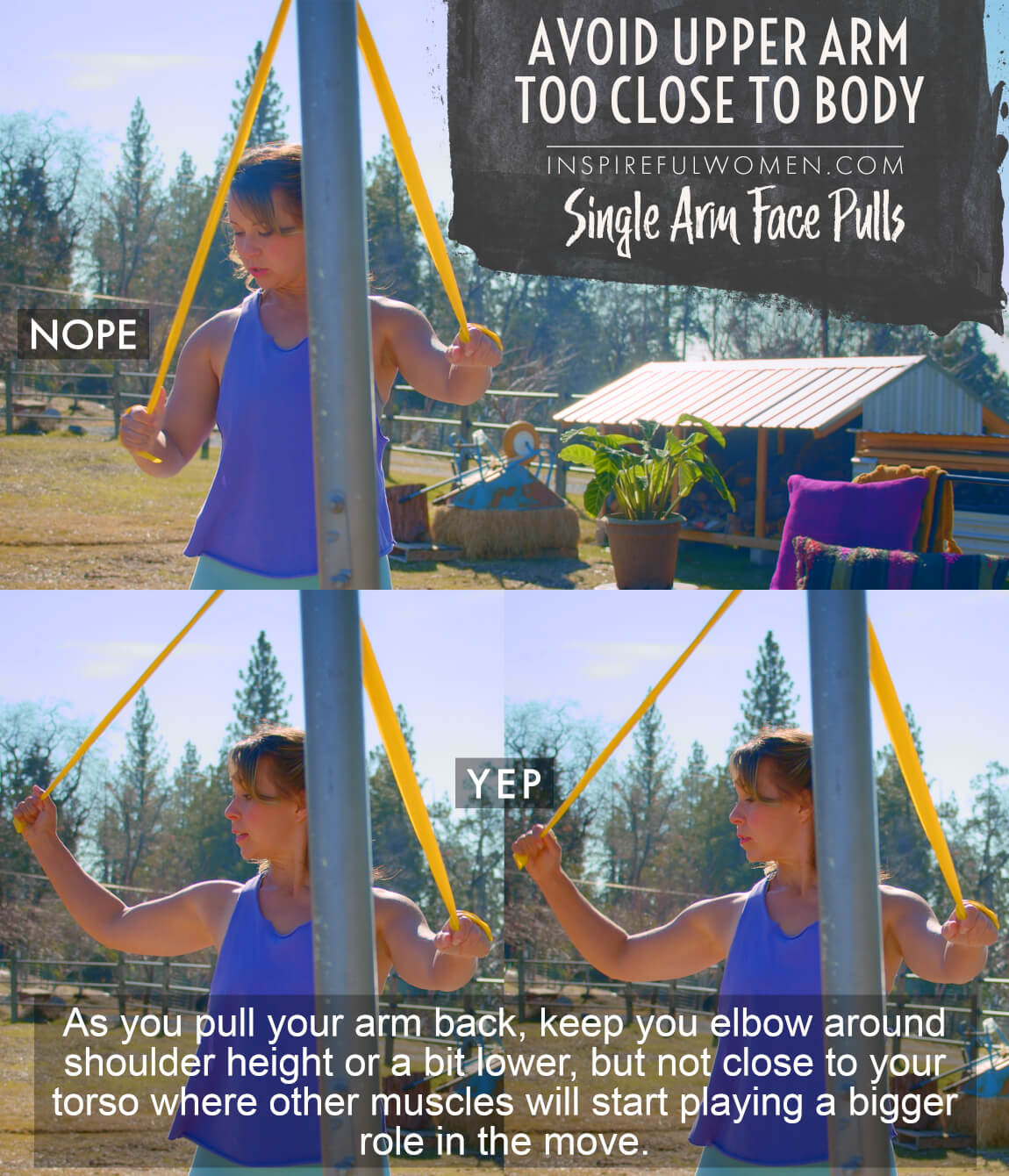
4. Avoid Shoulder Up To Ears
AVOID: Shoulder shrugging up to ear.
WHAT TO DO:
- Keep your shoulder pressed down.
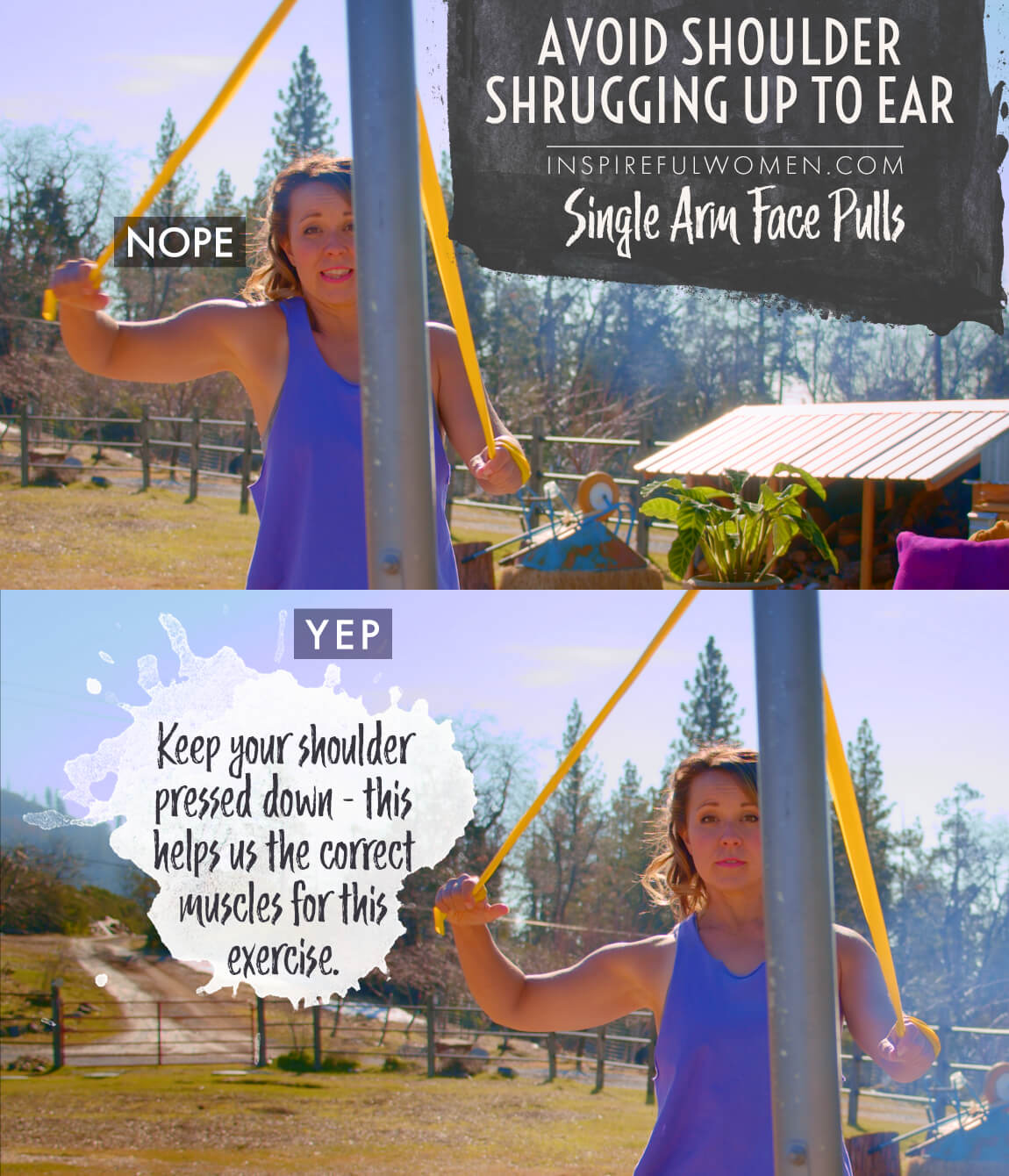
WHAT WE'RE DOING TODAY
WHAT & WHY
BENEFITS OF TRAINING THE Rear deltoid
WHAT
WORK SOME OF OUR MOST IMPORTANT MUSCLES- POSTURAL MUSCLES
Face pulls are exactly what they sound like- pulling something towards our face.
This exercise works the muscles of the back of the shoulder (the rear delt) and the upper back. The arms are held high and pulled back against the resistance of an elastic band. The movement of the arm comes from a combination of moving the shoulder blades and pulling the arms back. The shoulder blades move around the ribcage, in towards the spine - squeezing in to work the muscles of the upper back.
The back portion of the deltoid muscle, which lies on the back of the shoulder, works to pull the upper arm back. Towards the end of the movement, the upper arm rotates backward, you will feel a nice contraction in the back of the shoulder. These are the two main functions of the rear portion of the deltoid muscle - pulling the arm back and rotating it - so that the soft, underside of the arm turns to face up.
These are nice exercises to reverse the negative effects of too much sitting and working with our arms in front of us. Face pulls are really good for strengthening the muscles of the upper back and shoulder but they are also really good for stretching out the chest muscles. If you have a desk job, try taking a band to work, find a high place that you can anchor it, and do a few face pulls throughout the day.
WHY BOTHER DOING IT?
WHY
WHY DO WE EVEN CARE?
INCREASE OUR PULLING STRENGTH & GET BEAUTIFUL SHOULDERS
- Training rear delts does give a nice rounded appearance to our shoulders.
- Strengthening the back of our shoulder can help to increase our pulling strength, especially when our arms are further away from our bodies - like reaching out to the side of you like a corner kitchen cabinet to pull a heavier item off a shelf or to hold a heavy item with our arms away from our sides (I often have to do this in order to get said large item to clear the floor) - the ideal way to help move a heavy desk would be to keep my arms close to my body where more of my upper body muscles can help out, but being the short little person I am, I often have to bend my arms & hold them up high to hold my end of the desk off the ground.
REVERSE COMMON TIGHTNESS ON THE FRONT OF OUR UPPER BODY
The muscles of the upper back and the back of the shoulder are frequently overlooked during workouts. Some people joke that that is because you can’t see them in the mirror. Unfortunately, you can see the results when these muscles are neglected. Stooped posture is a common sign of aging, beginning as early as 40 years of age, and increasing dramatically after 60. The changes are most notable in the thoracic spine - the upper back. The thoracic spine becomes more rounded, which leads to the shoulder blades moving forward (protraction) which causes the shoulders to be rounded and the arms to turn inward.
Exercising the muscles on the front of the upper body (biceps, pectoralis, anterior deltoid), or tightness of those muscles due to long periods of sitting, driving, computer work, cooking (most of our daily activities) can encourage the upper back and arms to round forward. These changes interfere with the healthy movement of the shoulder joint and can lead to loss of motion, weakness, and pain. There is a lot that you can do to prevent these changes. Exercising the muscles of the back will help balance this out to improve the health of the shoulder joint and your posture.
IMPROVE THORACIC SPINE MOBILITY
There’s also this thing with our upper back - our thoracic spine - a tendency towards a forward curve & stiffness in this area of our back. Face pulls can help reverse this issue - working on being able to get movement through our upper back to get back some of that flexibility as well by actively pulling back against resistance & strengthening the muscle's ability to do that.
Face pulls can help prevent the changes in posture by working the upper back out of the forward curve (thoracic extension), strengthening the muscles that pull the shoulder blades back (retraction), and rotating the upper arm back. This movement trains and strengthens the muscles of the upper back, rotator cuff, and rear deltoid to improve upright posture and shoulder movement. This exercise focuses on pulling the arms back, and then externally rotating the arms - this helps to work the upper back towards extension (to counter daily activities that encourage rounding the spine forward. The movement will also stretch the muscles that pull the arms forward.
EVERYDAY LIFE
EVERYDAY LIFE &
MUSCLE FUNCTION
HOW WE USE OUR Rear Deltoid IN EVERYDAY LIFE
1. STABILIZES THE SHOULDER (REAR DELTOID, INFRASPINATUS, AND TERES MINOR)
- Keeps the head of the humerus centered in the socket (glenoid fossa)
- Pushing up from the floor
- Lifting
- Carrying, especially heavy loads
- Weeding
- Helps to prevent damage to the shoulder joint- wear and tear over time due to poor movement patterns
2. MOVES THE ARM BACK (REAR DELTOID ONLY)
- Reaching behind the back
- Pulling items towards you
- Reaching into the back seat
3. HELPS TO MAINTAIN UPRIGHT POSTURE (REAR DELTOID)
4. EXTERNAL ROTATION OF THE UPPER ARM (REAR DELTOID, INFRASPINATUS, AND TERES MINOR)
- Putting your hand in the back pocket (palm down)
- Turning outstretched arm with palm up for receiving change
- Catching a ball
- Reaching the back of your head
- washing/brushing/drying hair
HOW TO FEEL WHAT MUSCLE IS WORKING
How to Feel What Muscle is Working
Stand with your back against the wall, arms at 70 - 80 degrees of shoulder abduction, and 90 degrees of elbow flexion. Place the back of the upper arms and forearms on the wall. Push back with the upper arm and the hands into the wall. You should be able to feel the muscles between the shoulder blades, and the back of the shoulders work.
SCIENCY STUFF
SCIENCY STUFF
SPIFFILICIOUS FACTS ABOUT MUSCLES & MOVES
The movement of your arm would be very limited If you were to move just the arm or just the shoulder blade. The socket that the arm bone moves in is like a small cup on the shoulder blade. When you let your shoulders slouch, the cup is angled forward. You can feel this if you slouch, your upper arm will round forward. In order to get the arm behind the back, you have to angle the cup so that the arm can get to the back. From a slouched position, lift your arm to the side and try moving it behind your back. Now pull your shoulder blade back. Moving the shoulder blade back angles the cup to the side of the body. You should be able to move the arm further back. If the arm moves back without angling the cup out to the side, not only will it restrict your movement, it can irritate the soft tissues and the joint, causing damage over time.
The rear deltoids function is horizontal abduction/extension (lifting the arm up and moving it backward), and external rotation (rotating the upper arm up) of the shoulder joint. The rear deltoid works with the other parts of the deltoid muscle to stabilize the shoulder joint by positioning the head of the humerus (upper arm bone) in the center of the socket. The rear deltoid helps hold the shoulders back to limit rounded shoulder posture. The mid trapezius and rhomboids work together to pull the shoulder blades back from a protracted position. Retraction of the shoulder blade changes the position of the “socket” portion (the glenoid fossa) of the shoulder blade.
ALLLL MUSCLES & WHEN
ALL MUSCLES WORKING & WHEN DURING THE single arm face pull with thoracic rotation
The muscles of the legs and core will be active to hold the body still as the band is pulled back.
The beginning of the movement is initiated by scapular retraction (mid trap and rhomboids) and depression (lower traps) as the shoulder blades are pulled inwards (towards the spine), the rear deltoids move the arms horizontally into extension. The middle deltoid assists to hold the arm up in abduction. Once the arm is in line with the body the rear deltoid, infraspinatus and teres minor (2 rotator cuff muscles) externally rotate the upper arm. The obliques and the deep spinal rotators (multifidi and rotators - part of the transversospinalis muscle group) will work to rotate the thoracic spine.
PIN IT FOR LATER!

